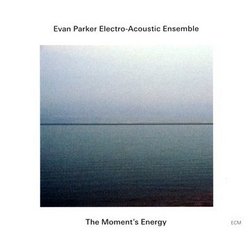Beautifully Strange Sounds
Richard L. Hulsebus | Daly City,CA | 08/04/2009
(5 out of 5 stars)
"This CD was very attractive to me just from the cover.A serene picture with the title,The Moments Energy.Beautiful.The music has grown on me and is still getting better and better after about 4 listens.The tasty melding of regular instruments and electronics is nice and kind of eerie.This stuff could be a good soundtrack to a good,creepy horror flick.Coffins creaking open and zombies and ghosts dancing slowly in a weird graveyard.Its also like a mixture of Stockhausen,Varese,and Cage but I might have to say better.Highly Recommended for open minds!"
A sonic journey where none have gone before...
R. Hutchinson | a world ruled by fossil fuels and fossil minds | 11/08/2009
(5 out of 5 stars)
"...led by the moment's energy, and a map of the terrain provided by that intrepid explorer Evan Parker. This is the best EPEAE recording since the first two, edgier and more provocative than the last two, which were also based on extended live recordings. TOWARD THE MARGINS (recorded 1996) and DRAWN INWARD (recorded 1998) were studio recordings (see my reviews). They both featured the core group of Evan Parker on sax, Barry Guy on bass and Paul Lytton on percussion. Originally each acoustic player had an electronic partner who processed their input in real time and interacted with the acoustic players. These albums had 6 and 7 performers, respectively, and 12 and 11 short pieces respectively. The music was fast and dense, and was recognizably free improv players in an electro-acoustic environment.
The next pair of ECM recordings moved to larger ensembles recorded live playing long pieces with numerous sections, and moved toward a slower, more spacious sound (MEMORY/VISION and THE ELEVENTH HOUR -- see my reviews). Recorded at the Ultima Festival in Oslo in 2002 and the Centre for Contemporary Arts in Glasgow in 2004 respectively, the Ensemble expanded to 9 and then 11 players. Phil Wachsmann's violin and Agusti Fernandez's piano played more prominent roles. The FURT electronic duo was added, leading to growing layers of processed sound. The tendency was in the direction of a sequence of solos featuring acoustic instruments and varying textures. While amazing by comparison to most standard types of music, I was beginning to feel that the EPEAE's sound was becoming too smooth, too ECM-ish, to contemplative and pretty, though that term must be understood in a relative sense.
With THE MOMENT'S ENERGY the Ensemble has expanded to 14 players. The title track, commissioned by and performed at the Huddersfield Contemporary Music Festival in 2007, is another long piece in 7 sections. Ned Rothenberg on woodwinds, Peter Evans on trumpet and Ko Ishikawa on sho have been added since THE ELEVENTH HOUR. Barry Guy returns on bass after missing that recording. It is not a live recording, but utilizes live and studio recordings in the final construction. The Ensemble's sound and modus operandi no longer bears much resemblance to an acoustic improv unit like the Parker/Guy/Lytton trio which was its founding nucleus. The improvised interactions are more between either an acoustic player and electronics or among processed sounds than among acoustic players. The focus is on varying density and varying textures.
By now the EPEAE sounds as much like an extended Xenakis electronic work such as LA LEGENDE d'EER or PERSEPOLIS (see my reviews) as it sounds like the first recordings from 1996. THE MOMENT'S ENERGY begins with processed percussion and strings being plucked and struck, recognizably sounds emanating from Lytton, Wachsmann and Fernandez. Woodwinds, trumpet and piano can be heard periodically throughout, but not in the stylized series of features that felt contrived in the last release. It concludes with an ethereal electronic coda that could be interpreted as a realization of peace, or enlightenment. The title is taken from a Rumi poem called "Father Reason," so perhaps there is something to this, as Rumi was, of course, a Sufi. The album ends with a 5-minute piece called "Incandescent Clouds," which thrusts the listener back into a zone of disharmony, countering any possibility of the album overall being perceived as New Age pablum.
Fantastic! All sounds have not yet been heard, and the future remains unwritten.
(verified purchase from Amoeba Records, San Francisco)
"

